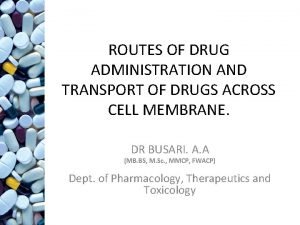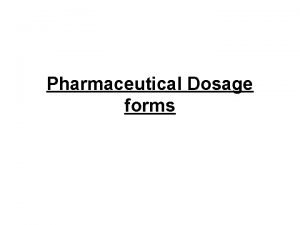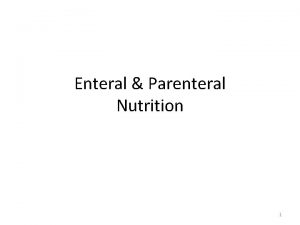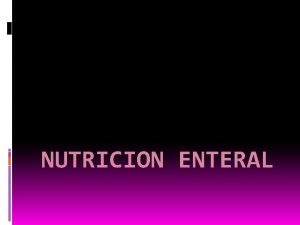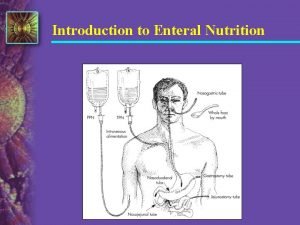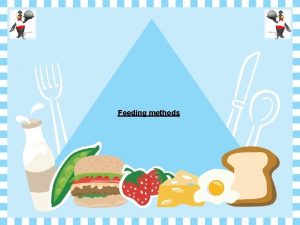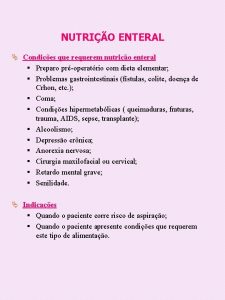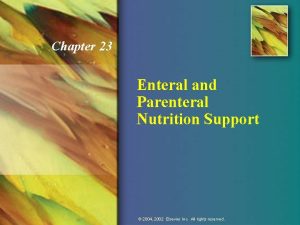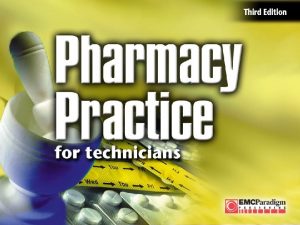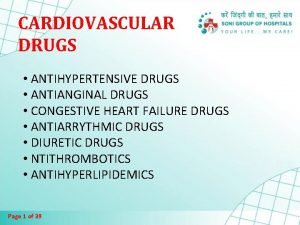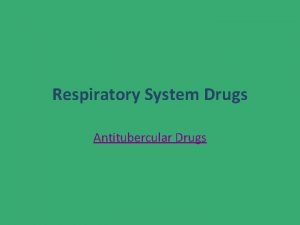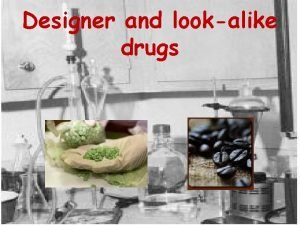Dose forms for enteral administration of drugs Enteral




























- Slides: 28

Dose forms for enteral administration of drugs

Enteral administration (via GIT) for systemic effect: A. Oral ingestion by swallowing : dose forms are either liquids, tablets, or capsules. Liquids such as clear solution; oral drops for infants, or syrup: more sweet than solution; it contains sweetening agent like sugar e. g. antibiotic syrup; or suspension: powder in water with added sweetening agent or coloring agent, if needed. Usually for local effect e. g antacids like aluminum hydroxide (Maalox) or alginate (Gaviscon), but sometimes systemic effect e. g. antibiotics Effervescent tablets are dissolved in water before ingestion as liquid, and are thus considered to belong to the liquid preparations







Tablets must undergo fragmentation, desintegration, & dissolution into liquid before drug can be absorbed. A tablet is a mixture of active substance with excipients, usually in powder form, packed under pressure to rounded or oval or other geometric forms of various sizes. . Excipients include : Fillers : e. g. inert substance e. g. lactose or starch that provide enough bulk to make handling and swallowing of tablet easy Lubricants : to ensure efficient tableting, and as flow aid Desintegrants : Ensure tablet breakdown in GIT fluids e. g. starch, sodium bicarbonate Sweeteners : To mask bad or bitter taste or give a sweet taste Colouring agent : pigment or dye to give visual attraction. A coating material may be added to make tablet resistant to


Capsules : the most efficient method to take drugs orally The ingredients are enclosed in relatively stable shell : Hard-shell : used for dry powder ingredients or granules Soft-shell : for oils or active ingredients suspended in oil Both shells are made from aqueous solution of gelling agent such as : 1. Animal protein (collagen) : mainly gelatin 2. Plant polysacharide derivative: like cellulose, carageenan Other ingredients added to gelling agent solution are : Plasticizers : e. g. glycerine or sorbitol to decrease hardness of shell Preservatives, Colouring agents , and Surface treatment



Modified release preparations : include : 1. Slow-release or extended (or sustained)release preparations lead to slow rate of drug release and absorption, thus a lower maximum level in plasma but longer duration of action. 2. Controlled release preparation release drug at fixed rate to get unvarying absorption and plasma level. 3. Delayed release means drug is not available for absorption shortly after administration but after some time at a different site e. g. in colon

Enteric-coated tablets or capsules : The enteric coating, usually thick gelatin, dissolves slowly in intestine and thus releasing drug for absorption. Has longest lag time for absorption. Can also hide bad or bitter taste of drug, & can extends its shelf life. It avoids gastric irritation and also destruction of drug by gastric acid or pepsin in stomach. Also avoids formation of non-absorbable drug-food complexes.


B. Sublingual (SL) administration : Dose forms : tablets (usually), sprays occasionally. - Quick effect (in few minutes) due to absorption under tongue direct into systemic capillary blood. GIT and liver are by-passed, so FPHE is avoided. Systemic bioavailability is high. e. g. Glyceryl trinitrate (GTN) tablets SL for relief of acute angina pectoris.


C. Rectal : suppositories: drug in wax or coconut oil that is solid at cool room temperature but can melt at core body rectal temperature to release drug for absorption; may also melt at high environmental temperature. Absorption from lower 1/3 of rectum directly to systemic blood via inferior rectal veins, but from upper rectum it goe to liver first by portal blood via superior rectal vein, thus exposed to FPHE. Absorption can be variable from lower rectum. Quick effect occurs. Indicated in: Vomiting. infants. Gastric irritants. Coma. High fever in children. Elderly


Enteral Administration for local effect: Oral for mouth : Lozenges gels sprays Mouth wash paints For lower esophagus : alginate For stomach: antacids, sucralfate, milk of magnesia, Bismuth For intestine : Activated charcoal castor oil Magnesium Cathartic For colon: Enemas, colonic washout, retention enema For rectum : suppositories for local effect, laxative Anal canal : ointment, gels : for local conditions like anal fissure, hemorrhoids


Absorption from GIT Drug must be lipid soluble Acidic drugs absorbed easily in stomach. Basic drugs absorbed mainly in small intestine. Factors affecting absorption 1. water solubility 2. MW and particle size 3. p Ka

4. Food intake. Food may reduce drug absorption from intestine due to dilution effect or binding to food proteins; fat in food delays gastric emptying; calcium in milk bind to & reduce absorption of tetracyclines 5. Gastric acidity and proteolytic enzymes may destroy & inactivate drug e. g. penicillin G, heparin, peptide hormones 6. Gastric emptying: enhanced by glass of water, also by prokinetic drugs like domperidone or metoclopramide which enhance drug intestinal absorption ; but delayed by exercise or by anti-muscarinic drugs (which would reduce rate of absorption by intestine) or during pregnancy which decrease rate of intestinal absorption. 7. Intestinal motility : enhanced by diarrhea or osmotic laxatives e, g. magnesium sulfate which allows less time for absorption.

8. Malabsorption: due to disease of small intestine e. g. Coeliac disease, pancreas, or biliary obstruction. 9. Intestinal blood flow : favours quick absorption. 10. Drug interaction in GIT: e. g. antacids containing aluminum reduce iron absorption 11. FPHE and liver disease Fractional oral systemic bioavailability (F) It is the fraction F or percentage (% F) of an oral dose of drug that reaches the systemic blood after its oral administration by swallowing.

Fractional oral systemic bioavailability (F) = AUC oral dose / AUC i. v. of same dose (%) F = F. 100 AUC is area under concentration-time (C-T) curve of drug. It represents amount of drug in plasma. F measures the extent of oral systemic bioavailability. Usually F is < 1 after oral drug administration by swallowing

Factors affecting oral F: Pharmaceutical factors GIT Factors affecting absorption FPHE & factors affecting it

Bioequivalence : A pharmaceutical term used to indicate if the extent and rate of bioavailability of one drug formulation is similar to that of another formulation of same drug. i. e. pharmaceutical bioequivalence. Such bioequivalent drug formulations are usually also therapeutically bioequivalent. Bioequivalence testing is required when the drug is synthesized by a different manufacturer or when a different method for its synthesis have been used.
 Cotrimazine is a fixed dose combination of drugs
Cotrimazine is a fixed dose combination of drugs Route of administration definition
Route of administration definition Dosage forms definition
Dosage forms definition Strong forms and weak forms
Strong forms and weak forms We were contracted form
We were contracted form Why are related forms more agreeable than unrelated forms
Why are related forms more agreeable than unrelated forms Why are related forms more agreeable than unrelated forms?
Why are related forms more agreeable than unrelated forms? Why are related forms more agreeable than unrelated forms?
Why are related forms more agreeable than unrelated forms? Handledning reflektionsmodellen
Handledning reflektionsmodellen Tidböcker
Tidböcker Vilken grundregel finns det för tronföljden i sverige?
Vilken grundregel finns det för tronföljden i sverige? Matematisk modellering eksempel
Matematisk modellering eksempel Jätte råtta
Jätte råtta Underlag för särskild löneskatt på pensionskostnader
Underlag för särskild löneskatt på pensionskostnader Verktyg för automatisering av utbetalningar
Verktyg för automatisering av utbetalningar Shivaismen
Shivaismen Hur stor skarns är det för ett barn att få cancer
Hur stor skarns är det för ett barn att få cancer Kyssande vind
Kyssande vind Romarriket tidslinje
Romarriket tidslinje Tack för att ni lyssnade bild
Tack för att ni lyssnade bild Strategi för svensk viltförvaltning
Strategi för svensk viltförvaltning Informationskartläggning
Informationskartläggning Tack för att ni har lyssnat
Tack för att ni har lyssnat Returpilarna
Returpilarna Centrum för kunskap och säkerhet
Centrum för kunskap och säkerhet Läkarutlåtande för livränta
Läkarutlåtande för livränta Inköpsprocessen steg för steg
Inköpsprocessen steg för steg Påbyggnader för flakfordon
Påbyggnader för flakfordon Egg för emanuel
Egg för emanuel

